2010 Season in Review
January 24th, 2011
The 2010 season brought another twist in our program. After exploring outside league opportunities and not finding one suitable to the organization it decided to create an in-house competitive youth tackle football league. One would be the younger league where 4th and 5th graders would play together and the other league would be for the 6th graders where I would be coaching.
With sixty 6th graders signed up, four teams were created with 15 players per team and 6-game round robin game schedule was formed. With limited numbers everything was compressed and faced new challenges how to approach the season in terms of practice organization and playing time. Without numbers and a set of rules to play under we had to be creative in how we taught our blocking and tackling and how to teach and run our offense and defense. Plus I had some ideas I wanted to implement with our flavor of the single wing offense and was confident it would work within these parameters.
Rules
The rules listed below were the pertinent ones.
Defense
1. No defender over center or snapper.
2. No more than 4-men on the line of scrimmage.
3. No blitzing and linebackers must line up at 3 yards from the ball.
4. Defense is not allowed to stimulate a snap.
Offense
1. Ball carrying weight limit of 120 LBS
2. No more than 2 wide receivers outside the offensive tackle on either side.
3. Pulling of offensive linemen will be allowed.
4. Motion will be allowed on offense as long as it is not used to crack block.
5. No crack blocks.
Position Name Changes
As a change of pace in 2010 I changed the position names for three of our players. The blocking back became the “modern” H-Back, The tailback became the Left-Back (L-Back) and the fullback became Right-Back (R-Back). This simplified things a bit plus our R- and L-Backs were essentially the same type of player where as in my mind a tailback and fullback were different. Our R- and L-Backs both run sweeps, off-tackle, wedges and execute the sweep passes. In the traditional single wing the fullback was typically an interior runner but from 2008-2010 our two deep backs were halfback players.
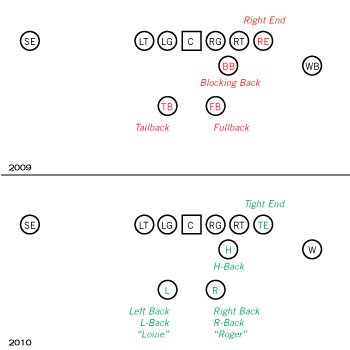
Formations
One of the major changes to our offense in 2010 was formations. Strategically I have found teams at my level will adjust/shift their defensive strengths based on our wingback, tight end or H-Back. Once we figure it out we can use our formations to put them where we want and attack accordingly. For some reason it is normally the wingback in my experience. This past season most teams were either keying the wingback or the tight end until the last game when it was the H-Back which took us a little while to figure out because it has been so rare. Their best inside linebacker was mirroring the H-Back alignment’s side so we naturally ran a high number of Half Spin Counters opposite the H-Back’s alignment.
In 2009 we scaled back the formations we used in comparison to what we used in 2008 due to rules and the position where our program was. For 2010 I wanted to look into expanding the number formations but within the scope of the new rules. We had great success in 2008 running power off-tackle when we used a split end on the strong side. I felt like we essentially removed the cornerback from the point of attack. In 2009 when we could not use a split end and wingback together the cornerback was a factor at the point of attack so we designed the blocking to handle it. I didn’t like him there so how could I get him out of there? My answer was to widen out our wingback 10-12 yards away from the core structure of the formation. Instead of having the wingback block the linebacker on our power off-tackle play and the lead backfield blocker leading through the hole looking for the cornerback, we switched their jobs. Now we had a better blocker on the linebacker and had the cornerback outside which made things less congested. This formation is similar to the Pro-Set.
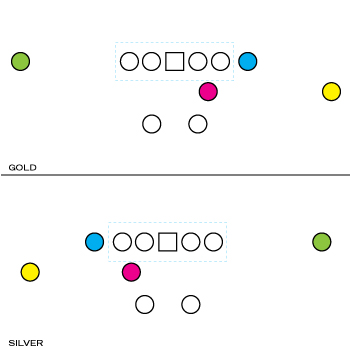
The next area I looked at was what worked in 2009 and noticed we had success running the ball off-tackle to the left side where we had only a guard, tackle and split end. In 2009 we used three linemen on the right side exclusively which also presented interesting problems for defenses and we had success running off-tackle there as well. So I thought why not use both ideas on each side?
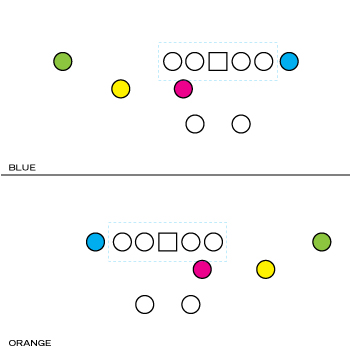
The more I looked at it I decided that the third lineman really should be a tight end (TE), not another tackle. So I began to look at the core formation as a static group of five interior lineman and two running backs. These seven players never lined up in another spot. This allowed me to use numerous combinations aligning the split end, tight end, H-Back and wingback to create formations that mirrored each other on the left as well as the right side. We still called our formations by colors. I could have used tags in order to move the individual player positions but this would have been too difficult with our no-huddle system.
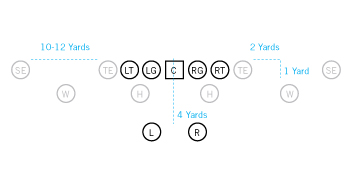
One alignment and play we eliminated from the 2009 playbook was the wedge play snapped to the blocking back, or what we called the H-Back in 2010. This was because the player that played this position was over the ball carrying weight. However he played the same position in 2009 and I felt I still needed him to play the crucial position again in 2010 so we adjusted where he couldn’t carry the football in run plays nor pass plays.
No-Huddle
We kept the same method of calling plays from the no-huddle. I shouted out the formation color and then use hand signals to call the play – series (Power, Half, Wing) and point of attack (1-5). We practiced this method in practice from the very start of camp at many different speeds. Additional signals we used were “Pass” and “No Play”.
Multiple Off-Tackle Approach
As in the past we focused heavily on an off-tackle attack since it was our bread and butter in the past and it’s the way I want my teams to play. Most youth defenses focus on stopping the sweep but dislike stopping the off-tackle play because of the power and numbers it brings at the point of attack. We used a steady diet of straight power plays mixed in with half spin counters and wingback counter plays to either side of the formation. Just as we did the past two seasons we had three different modes to attack off-tackle.
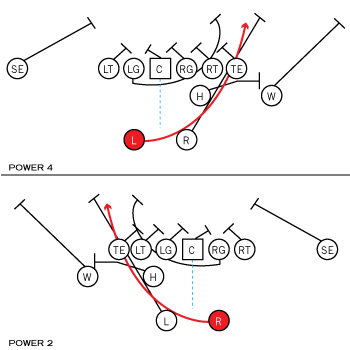
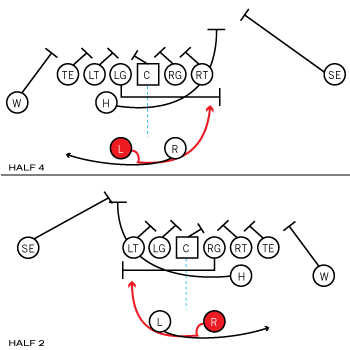
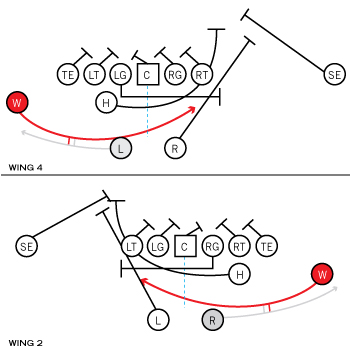
Blocking
In 2010 I wanted to make another change to our offense. Since I was going to be altering the way I looked at formations I also wanted to alter the way I ran our power series blocking. The past two seasons I only pulled the right guard in either direction to either lead block into the hole at the point of attack or kick out at the point of attack. For 2010 I decided to pull the back side guard, either the left or right guard, to conduct these duties.
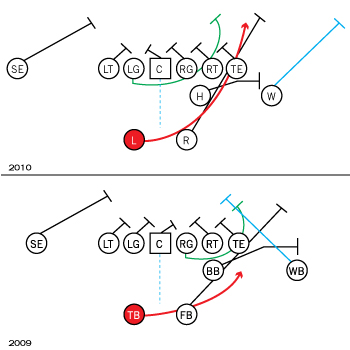
Another change in our blocking was sweep blocking. When we ran sweeps in 2010 we typically ran them to the tight end side because we pulled the play side guard on those plays and this allowed our tight end and tackle to down block effectively. I felt it would be too far for the back side guard to run and be effective enough on sweeps to the opposite side. This worked well enough for our Power and Half Spin series sweep plays as well. We don’t run a lot of sweeps but did run more Power series sweep plays in 2010 than we did in 2009.
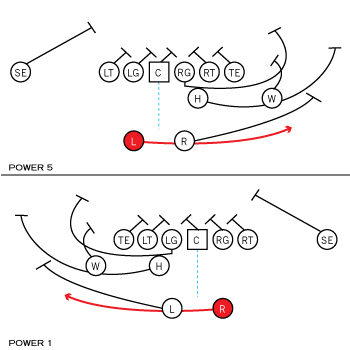
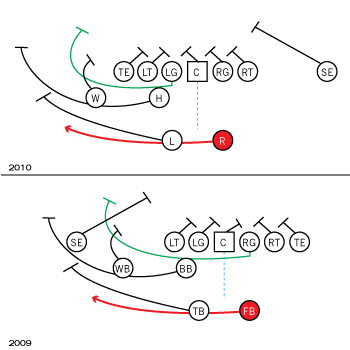
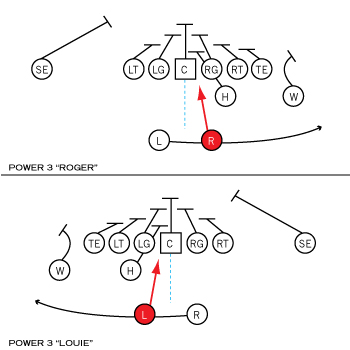
Wedge plays were called with me signaling in the play and calling out either “Roger” or “Louie” to tell our team who was taking the snap and running the ball into the wedge. The other conducted a fake by either faking a sweep, a pass or if the play was Wing 3 then he would fake the wingback counter with the wingback.
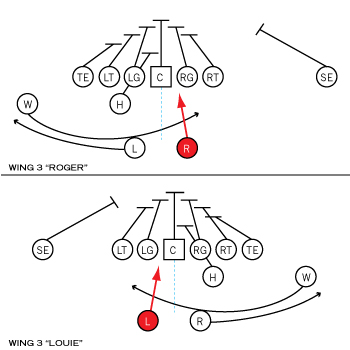
Power Series Passes
Our two deep backs, the Right Back (“Roger”) and Left Back (“Louie”) were two similar players for us and our two workhorses. While neither had blazing speed they made up with great toughness and instincts. I tried to share the load with these two since we didn’t have great depth which kept both players as fresh as possible and both were effective lead blockers for each other. We focused on off-tackle plays and could run them from multiple sets.
Additionally both players were also capable passers on our sweep pass plays. We ran them both to the left and right. This year we did not have the H-Back go into the pass route but had the tight end (TE) run the route to the flat. He was a taller player with good hands and became the primary target on these plays. We passed more in 2010 than I had in any season prior and had the most success on PATs.
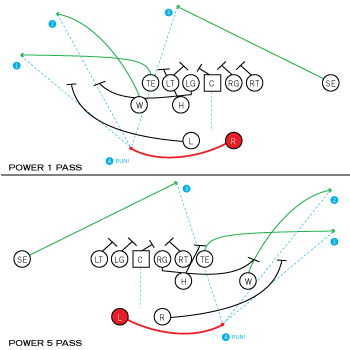
Counter Plays
The backfield action of the the Wingback Counter as well as the Half Spin Counter plays has the been the same for me the past thee season and you can read about that here and here. The blocking for these plays in 2010 was slightly different to match the techniques we were using for the power series. On both plays the back side guard pulled and kicked out the first opponent he encountered and the H-Back, who was aligned on the opposite side of the point of attack, hustled and lead into the hole.


The scheme is very similar to the Counter Trey scheme found at all levels of football. I learned the Half Spin Counter series from Dr. John Ward and he, as well as other teams, will pull both the back side guard and tackle but I do not. Dr. Ward will keep his H-Back home to fill for the pulling linemen. However, I use the H-Back to lead instead of the tackle who stays home because at our level the H-Back will be a better athlete than the tackle so I feel he will have a better impact on the success of the play. Urban Meyer often employs his H-Back/tight end on his version of the Counter Trey as well.
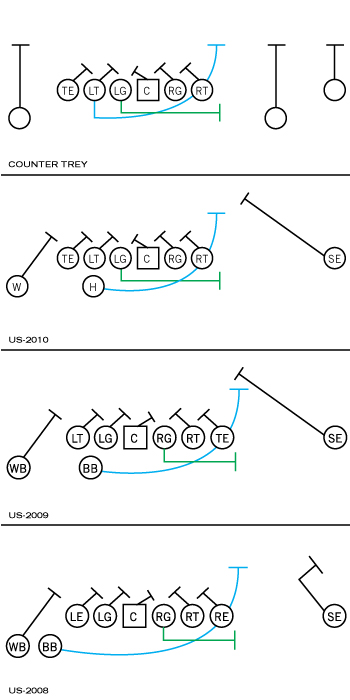
The 2010 season capped a very successful three-year run with this style of single wing offense going 17-1. We discovered over this period that the offense is very flexible to make changes and maintain the structure, power and deception with different formations, blocking ideas, new players, minimal practice time and playing rules.
If you would like a copy of the full playbook, please e-mail me.
Snap & Go!
Adam
adam_wesoloski at yahoo.com